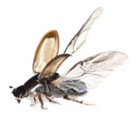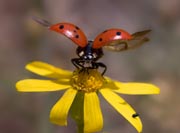Flashing Fireflies
Fireflies (or lightning bugs) are not really flies at all – they are a type of beetle. If you live on the eastern side of the U.S. where it is warm and humid, there is a good chance that these bugs will be out at night during the summer. Try catching a few and observing them up close. You can stay in your own backyard, or go to a park or field nearby. Bring an adult to help you.
Note: If there are no fireflies where you live, you can observe beetles during the day. Use a jar with a paper towel secured with a rubber band as a Beetle Viewer, and hunt for beetles in grass, on trees, or crawling in dirt. Release the beetle back where you found it after you have looked closely using a magnifying glass.
- As it starts to get dark wait and watch for little sparks of light that fireflies make. When you see quite a few of these insects hold up a glass jar and gently cup your hand around one to catch it and put it in the jar. Quickly put a paper towel or a thin piece of woven cloth over the opening and hold it in place with your hand so the firefly cannot escape.
- Catch several insects this way, until the jar has a faint glow. Keep the paper towel over the opening of the jar and wrap a rubber band around it. This way the fireflies will have plenty of air.
- Notice the different flashing patterns. How often do these bugs flash? How long is the flash? Do you think there are multiple kinds of fireflies in the jar, or just one? Count how many flashes there are in 5 minutes, how long the flashes are (in seconds) and how many seconds between the flashes. Have your adult helper write down your observations.
- When you are done observing the lightning bugs, remove the paper towel, and let them go.
What Happened:
Different kinds of lightning bugs have different flash patterns. Some blinked and winked quickly, while others lit up fewer times, but for longer. Are there many different types of lightning bugs where you live, do you think? Try this experiment on a different night and see what happens. Beetles are fascinating to observe – and there are so many different kinds all around us!
Beetle Body Parts
Use this worksheet to make a beetle with moving parts! You will also need 4 brass brads and an adult to help you. You might already know that beetles have three body parts and six legs. They also have some other special features that make them different from other insects. The beetle on the worksheet is a Darkling beetle, but all beetles have similar body parts and the same unique features.
- Cut out all the pieces, staying close to the black lines. You might need an adult to help with this part. It’s okay to leave white space around the small parts like the antennae and legs when you cut them out.
- Find the head. It looks like a circle with two squiggly lines (these are the antennae) on the top. Next find the thorax, which is the middle body section of all insects, and has six beetle legs on it. Notice the black dots that are marked with numbers.
- Have an adult poke a brad through the black dot (1) on the head, and then through the black dot (1) on top of the thorax. Turn the paper over, and close the brad by bending one end one way, and the other end the opposite way.
- Find the abdomen. This is the last part of the body, and has different segments or sections. Have your helper poke a brad through the very bottom dot on the thorax (2), and then the top dot on the abdomen (2). Close the brad to keep the layers together.
- Match up the wings to the beetle’s body (3), making sure that the long pair of wings is on the bottom, and the short striped pair is on top. Have an adult poke a brad through all three layers of paper on the right and left sides of the beetle. Close the ends of both brads.
- Make your Darkling beetle fly or crawl by moving its wing pairs out or in and up and down.
What Happened:
 Most flying insects have one pair of wings (butterflies have two – can you think of any others?). All beetles have two pairs of wings. The first pair is very thin, which works great for flying, but can be broken easily. That is why beetles also have a second pair of wings that is hard and thick, and makes a great protection for this fascinating bug. The inside wings actually fold up inside the tough outside wings on the beetle’s abdomen when it is not flying. Some beetles don’t use their wings very much. The Darkling beetle only uses its wings when it needs to fly long distances to find food.
Most flying insects have one pair of wings (butterflies have two – can you think of any others?). All beetles have two pairs of wings. The first pair is very thin, which works great for flying, but can be broken easily. That is why beetles also have a second pair of wings that is hard and thick, and makes a great protection for this fascinating bug. The inside wings actually fold up inside the tough outside wings on the beetle’s abdomen when it is not flying. Some beetles don’t use their wings very much. The Darkling beetle only uses its wings when it needs to fly long distances to find food.
Another feature of the Darkling beetle is on its head. Do you see the two short things sticking out near the antennae? These are part of the insect’s jaw, called a mandible. You might have also noticed the tiny eyes on the Darkling beetle. Beetles have small compound eyes that are usually at the very front of their head. Beetles can see directly in front and above without moving their head. They use their antennae to help sense what is on each side of them.
All About Beetles
 Why are beetles called beetles? Well, no one really knows, but it does sound a lot like an Old English word we don’t use any more that means ‘little biter’. Do beetles really bite? Yes, but most beetles have mouths too tiny to bite humans. Another name for beetles is Coleoptera (ko-lee-AHP-tare-uh), and this one seems to fit better. The scientific name for beetles, Coleoptera, comes from two Greek words: ‘koleos’ means shield and ‘ptera’ (say: tare-uh) means wings. Beetles are winged insects that have tough outer wings like a shield. All beetles have two sets of wings – their body is covered by a hard shell (called an elytra) that protects the thin wings underneath that are used for flying. The thin flying wings fold out from under the elytra when the beetle is ready to take off. The outside wings have color and texture, which is why ladybugs look red with black spots when they crawl, but look more transparent (see-through) when they are flying.
Why are beetles called beetles? Well, no one really knows, but it does sound a lot like an Old English word we don’t use any more that means ‘little biter’. Do beetles really bite? Yes, but most beetles have mouths too tiny to bite humans. Another name for beetles is Coleoptera (ko-lee-AHP-tare-uh), and this one seems to fit better. The scientific name for beetles, Coleoptera, comes from two Greek words: ‘koleos’ means shield and ‘ptera’ (say: tare-uh) means wings. Beetles are winged insects that have tough outer wings like a shield. All beetles have two sets of wings – their body is covered by a hard shell (called an elytra) that protects the thin wings underneath that are used for flying. The thin flying wings fold out from under the elytra when the beetle is ready to take off. The outside wings have color and texture, which is why ladybugs look red with black spots when they crawl, but look more transparent (see-through) when they are flying.
Do beetles have compound eyes like flies do? Most insects have compound eyes. That means that instead of seeing one view like we do with our eyes they have many different parts to their eyes, and each part sees a slightly different picture. Since insects can’t twist their head around as much as we can, their compound eyes allow them to see what is around them. Insects with compound eyes see multiple views all at once! Most beetles have compound eyes in the very front of their heads so they are able to see what is in front of them, and then they use their antennae to sense what is around them, or even behind. Some beetles, including ladybugs, have eye spots, which are just white dots on their head that fool their predators and help protect their compound eyes.
When we think of beetles we usually think of small insects, like ladybugs. There are many different kinds of beetles however, and some of them are huge! The longhorn beetle is the biggest insect and its body can reach up to 6.5 inches, with antennae that are even longer! Just like any beetle, the longhorn beetle has compound eyes, and uses its antennae to feel what is in front, around, and behind it. The goliath beetle found in Africa can weigh up to 3.4 oz (almost 1/4 pound), and is the heaviest insect ever found on earth.
There are many other fascinating beetle species. Most beetles are able to fly, but some have wings that they never use. Some beetles are able to swim (as well as crawl and fly), and make their home in the water. Because of how many different kinds (or species) there are, beetles are able to live in different places across the earth – from dry deserts to swampy wetlands. Next time you see a beetle, think about how amazing it is that this little creature is able to survive so well. Most beetles live for about 3 months, and in that time see rain and shine, hot and cold, and they still keep crawling along.
Beetles hatch from eggs, which their mother lays on leaves or plants. When the eggs hatch the baby beetle looks almost nothing like an adult. At this stage of life, a beetle is called a larva. Larvae (what you call larva when there is more than one) look sort of like worms, or short caterpillars, and they have many body segments and short legs. The purpose that every larva has is to eat and grow. When it has grown enough, it turns into a pupa (say it like: pyoo-puh). Pupae have a thin shell around their bodies, and don’t move or crawl. It’s almost like they are in a sleeping bag, but when they wake up, they come out of their shell, and instead of looking like a short worm, they are a fully formed beetle, with three body parts and six legs.
The four stages of egg, larva, pupa, and adult beetle, are called a life cycle. You may have heard about the life cycle of a butterfly, and how it changes from a caterpillar into a beautiful winged insect. The life cycle of beetles is very similar, only we don’t notice it as much, because beetles at every stage of life are usually low to the ground, or even live under leaves or burrowed in the ground.
Printable Worksheet & PDF
Use this coloring sheet to review the life cycle of beetles. Find the project worksheet here to create your own model of a Darkling Beetle.





